

Activities of daily living (ADLs) are basic tasks that we perform every day without thinking about them. They include activities such as eating, bathing, dressing, toileting, and transferring (moving from one position to another). Instrumental activities of daily living (IADLs) are tasks that are a bit more complex than ADLs. They include activities such as cooking, cleaning, doing laundry, and managing money. IADLs often require the use of tools or other objects to complete the task. You can download the Activities of Daily Living Worksheet below but first let us explain which one you may need and how best to record values for them correctly.
For most people, ADLs and IADLs are performed without any difficulty. However, for some people, these activities can become difficult or impossible to do due to physical or cognitive impairments. When this happens, it is called functional decline. The functional decline can have a major impact on a person’s quality of life and independence. Therefore, it is important to be aware of the signs of functional decline and to get help if needed.
If you are worried about your own or someone else’s ability to perform ADLs and IADLs, talk to a doctor or other healthcare professional. They can assess the situation and provide guidance on how to best proceed.
Table of Contents
There are many reasons why you might want to keep track of your ADLs and IADLs. For example, if you are an older adult, tracking your activities can help you or your doctor spot early signs of functional decline. This information can then be used to make changes in your life that may help prevent further decline.
In addition, tracking your activities can help you to see how your abilities have changed over time. This information can be useful in making decisions about your care or treatment. For example, if you are considering surgery, you may want to know how well you have been able to perform activities since your last operation.
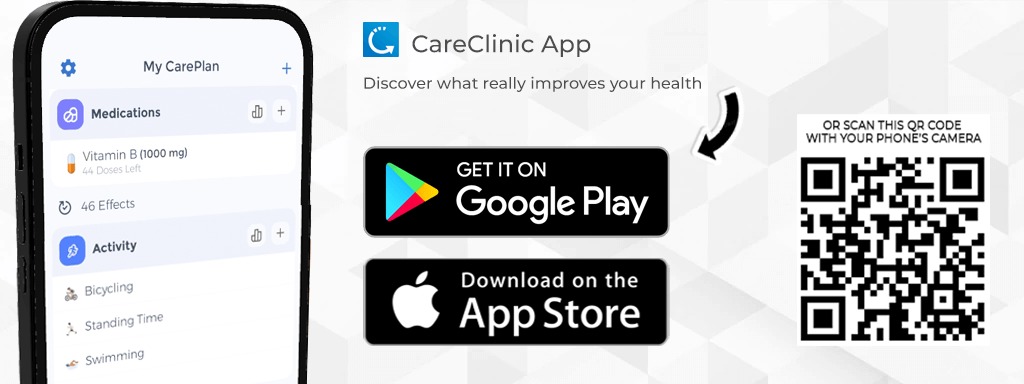
Anyone can track their ADLs and IADLs. However, this method may be beneficial for older adults or people with chronic health conditions.
There are many ways to track your ADLs and IADLs. One option is to use a daily log. This can be as simple as a piece of paper or an online form. Each day, you would write down which activities you performed and how well you could do them.
Another option is to use a smartphone app. There are many different apps available, so you may want to try out a few to see which one works best for you. Once you have chosen a method, it is important to be consistent in how you use it. This will make it easier to spot trends over time.
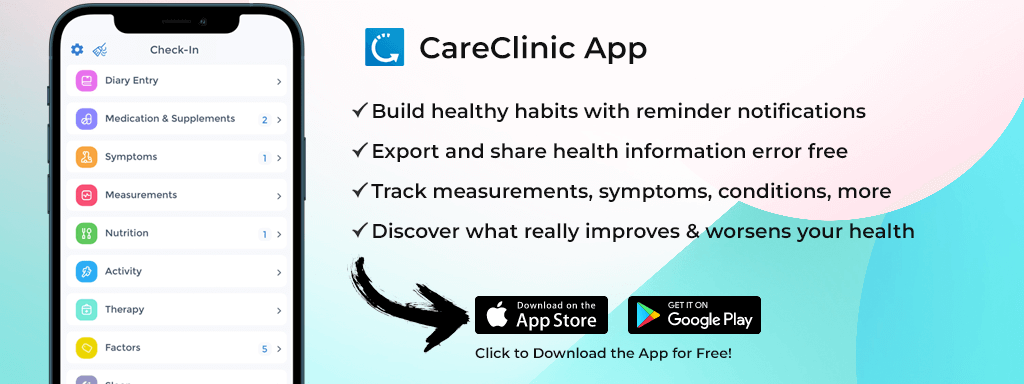
The six daily living activities are:
These activities are important for people to be able to do on their own. If a person is unable to do one or more of these activities, they may need help from others.
If you would prefer to use a paper form, you can download and print a PDF version of the ADL tracking worksheet.
Day 1
Activity, Rating, Comments
Washing face, 5
Brushing teeth, 5
Showering, 5
Dressing, 5
Using the toilet, 5
Eating, 5, low appetite
You can record this and more in the Activities of Daily Living Worksheet Printable PDF below:
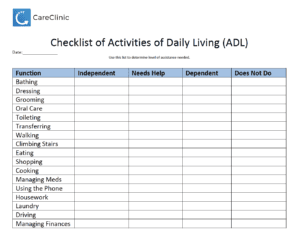
Logging activities of daily living (ADLs) and instrumental activities of daily living (IADLs) in CareClinic is easy! Just follow these simple steps:
You can see how this process looks in the app (in dark mode) and in regular mode below:

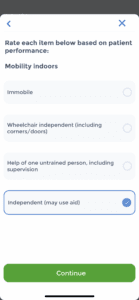
You may also begin to log your data using the “Factors” Tracker along with other Trackers to save more details for you to review later. Here is an example of how entries would look if Trackers were used.
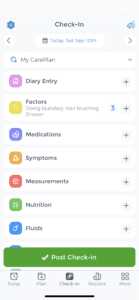
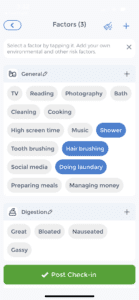
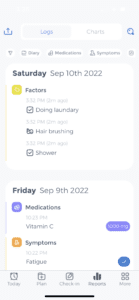
There is no one disease that requires tracking of ADLs and IADLs more than others. However, functional decline is a common symptom of many chronic diseases, such as Dementia, Parkinson’s disease, and stroke. Therefore, people with these conditions may find it helpful to track their activities.
The Katz ADL scale is a tool that can be used to measure functional decline. It consists of six items: bathing, dressing, toileting, transferring, continence, and feeding. Each item is rated on a scale from 0 to 4, with 0 being unable to perform the activity and 4 being able to perform it without any difficulty.
A 0–2 on any item indicates that the person is dependent on others for that activity. A score of 3–4 on all items indicates that the person is independent in all activities.
The Katz ADL scale can be used to track functional decline over time. It can also be used to compare different people or groups of people. For example, the scale can be used to compare the functional abilities of older adults with and without dementia.
The Barthel ADL index is another tool that can be used to measure functional decline. It consists of 10 items: feeding, grooming, bathing, dressing, transferring, toileting, ambulation, stair climbing, bladder control, and bowel control. Each item is rated on a scale from 0 to 20, with 0 being unable to perform the activity and 20 being able to perform it without any difficulty.
A score of 0–59 indicates that the person is dependent on others for activities of daily living. A score of 60–100 indicates that the person is independent in all activities.
The Barthel ADL index can be used to track functional decline over time. It can also be used to compare different people or groups of people. For example, the scale can be used to compare the functional abilities of older adults with and without stroke.
The Lawton IADL scale is a tool that can be used to measure functional decline. It consists of eight items: using the phone, shopping, preparing meals, doing housework, taking medications, handling money, using transportation, and being able to get out of bed. Each item is rated on a scale from 0 to 4, with 0 being unable to perform the activity and 4 being able to perform it without any difficulty.
A score of 0–2 on any item indicates that the person is dependent on others for that activity. A score of 3–4 on all items indicates that the person is independent in all activities.
The Lawton IADL scale can be used to track functional decline over time. It can also be used to compare different people or groups of people. For example, the scale can be used to compare the functional abilities of older adults with and without dementia.
The functional independence measure (FIM) is a tool that can be used to measure functional decline. It consists of 18 items: self-care, sphincter control, transferring, locomotion, communication, and social cognition. Each item is rated on a scale from 1 to 7, with 1 being unable to perform the activity and 7 being able to perform it without any difficulty.
A score of 1–2 on any item indicates that the person is dependent on others for that activity. A score of 3–7 on all items indicates that the person is independent in all activities.
The FIM can be used to track functional decline over time. It can also be used to compare different people or groups of people. For example, the scale can be used to compare the functional abilities of older adults with and without stroke.
The rehabilitation outcome measure (ROM) is a tool that can be used to measure functional decline. It consists of nine items: daily living activities, mobility, self-care, employment, recreation and leisure, education, social function, family function, and community function. Each item is rated on a scale from 0 to 6, with 0 being unable to perform the activity and 6 being able to perform it without any difficulty.
A score of 0–3 on any item indicates that the person is dependent on others for that activity. A score of 4–6 on all items indicates that the person is independent in all activities.
The ROM can be used to track functional decline over time. It can also be used to compare different people or groups of people. For example, the scale can be used to compare the functional abilities of older adults with and without stroke.
The functional assessment measure (FAM) is a tool that can be used to measure functional decline. It consists of 10 items: daily living activities, mobility, self-care, employment, recreation and leisure, education, social function, family function, community function, and global function. Each item is rated on a scale from 0 to 6, with 0 being unable to perform the activity and 6 being able to perform it without any difficulty.
A score of 0–3 on any item indicates that the person is dependent on others for that activity. A score of 4–6 on all items indicates that the person is independent in all activities.
The FAM can be used to track functional decline over time. It can also be used to compare different people or groups of people. For example, the scale can be used to compare the functional abilities of older adults with and without stroke.
The performance-oriented mobility assessment (POMA) is a tool that can be used to measure functional decline. It consists of six items: standing, walking, stair climbing, transfers, arm movements, and leg movements. Each item is rated on a scale from 0 to 4, with 0 being unable to perform the activity and 4 being able to perform it without any difficulty.
Dependent people have a score of 0–2 on any item. A score of 3–4 on all questions indicates that the person is independent in all areas. The POMA can be used to track functional decline over time. It can also be used to compare different people or groups of people. For example, the scale can be used to compare the functional abilities of older adults with and without stroke.
The Bristol Activities of Daily Living Scale is a tool that can be used to measure functional decline. It consists of six items: bathing, dressing, toileting, transferring, continence, and feeding. Each item is rated on a scale from 0 to 4, with 0 being unable to perform the activity and 4 being able to perform it without any difficulty.
A 0–2 on any item indicates that the person is dependent on others for that activity. A score of 3–4 on all items indicates that the person is independent in all activities.
The Bristol Activities of Daily Living Scale can be used to track functional decline over time. It can also be used to compare different people or groups of people. For example, the scale can be used to compare the functional abilities of older adults with and without stroke.
The best scale for you will depend on your needs and preferences. Some factors to consider include:
Once you have considered these factors, you can choose the scale that best suits your needs. For example, Bristol Activities of Daily Living Scale, if you want to track your activities over time pr Lawton scale if you need a more detailed assessment.
The amount of time it takes to track your ADLs and IADLs will depend on the method you choose. A daily log can take just a few minutes each day. However, a home health assessment may take an hour or more.
You can track your ADLs and IADLs yourself, or you can have someone else do it for you. If you are tracking your own activities, it is important to be consistent in how you record them. This will make it easier to spot trends over time.
If you have someone else track your activities, they will need to be familiar with the method you are using. For example, if you are using a smartphone app, they will need to know how to use the app and how to enter the data.
The frequency of tracking will depend on the purpose of the tracking. For example, if you are tracking your activities to spot trends over time, you may want to do it daily or weekly. If you are tracking your activities for a home health assessment, you may only need to do it once.
There is limited evidence on the use of ADL and IADL tracking. However, one study found that tracking functional decline can be useful in predicting the need for long-term care. Another study found that tracking functional decline can help identify people at risk for falls. This is important because falls are a leading cause of injury in older adults.
ADL and IADL tracking is done in both nursing homes and communities. In nursing homes, it is often used to assess the need for long-term care. In communities, it is often used to identify people at risk for falls.
If you are unable to do an activity, you can ask for help from another person or use adaptive equipment. For example, if you are unable to dress yourself, you can ask someone else to help you or use adaptive clothing.
Overall, the use of activities of daily living worksheets can be beneficial in a variety of ways. They can help individuals track their progress over time, identify areas where they may need assistance, and predict the need for long-term care. You can get started by printing the free ADL file above every time you want to record values for yourself or your dependent or you can download the CareClinic app for iOS or Android and record it as many times as you need to without ever needing to print another copy. Whatever you chose, make sure you get started!
![]()
Akshay, the Founder of CareClinic, is driven by his passion to improve healthcare. He regularly hosts a self-care podcast, featuring experts from diverse health fields, showcasing his commitment to enhancing health and wellness knowledge. Akshay aims to leverage his expertise and innovative approach to simplify health and wellness management for all, reflecting his dedication to making healthcare more accessible and user-friendly.
Latest posts by Asher (see all)